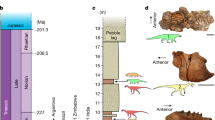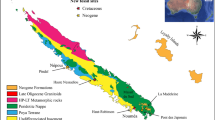Abstract
MOST geologists agree on the placement of the continents at the end of the Cretaceous. Palaeobiologists, however, hold divergent opinions1,2. Some workers connect South America to Africa, some connect it only to North America, while others isolate South America totally. New evidence from vertebrate palaeontology suggest that a substantial land connection between North and South America existed 85–100 Myr ago which facilitated the passage of many terrestrial vertebrates between the continents, including large herbivorous dinosaurs. Specimens of hadrosaurian dinosaurs, collected in the first half of the present century, have now been used to reanalyse not only the palaeobiogeography but also the classification and phylogeny of this group. 1 report here the first solid evidence of an extensive land connection for large terrestrial vertebrates of this sort between North and South America at the end of the Cretaceous.
This is a preview of subscription content, access via your institution
Access options
Subscribe to this journal
Receive 51 print issues and online access
$199.00 per year
only $3.90 per issue
Buy this article
- Purchase on Springer Link
- Instant access to full article PDF
Prices may be subject to local taxes which are calculated during checkout
Similar content being viewed by others
References
Kauffman, E. G. The Mountain Geologist 14, 75–99 (1977).
Tedford, R. H. Soc. Econ. Paleo. Min. Spec. publ. No. 21, 109–126 (1974).
Bakker, R. T. Nature 238, 81–85 (1972).
Brett-Surman, M. K. thesis, Univ. Calif. (1975).
Ostrom, J. H. Bull. Am. Mus. nat. Hist. 122, 35–186 (1961).
Lull, R. S. & Wright, N. E. G. S. A. Spec. pap. No. 40 (1942).
Gilmore, C. W. Bull. Am. Mus. nat. Hist. 67, 23–78 (1933).
Casamiquela, R. Ameghiniana 9, 285–309 (1964).
Baird, D. & Horner, J. New Jers. Acad. Sci. Bull. 22, 50 (1977).
Rozhdestvenskii, A. K. Int. Geol. Rev. 9, 556–566 (1967).
Smith, A. G. & Briden, J. C. Mesozoic and Cenozoic Paleocontinental Maps (Cambridge University Press, 1977).
Von Huene, F. Revista De Museo De La Plata (1929).
Dodson, P. Syst. Zool. 24, 37–54 (1975).
Author information
Authors and Affiliations
Rights and permissions
About this article
Cite this article
BRETT-SURMAN, M. Phylogeny and palaeobiogeography of hadrosaurian dinosaurs. Nature 277, 560–562 (1979). https://doi.org/10.1038/277560a0
Received:
Accepted:
Published:
Issue Date:
DOI: https://doi.org/10.1038/277560a0
This article is cited by
-
New hadrosaurid remains from the Late Cretaceous of Río Negro Province (Argentina, Late Cretaceous)
Journal of Iberian Geology (2017)
-
Erster Nachweis eines Hadrosauriers (Ornithischia) aus dem unteren Garumnium (Maastrichtium) des Beckens von Tremp (Provinz Lérida, Spanien)
Paläontologische Zeitschrift (1984)
-
A pachycephalosaurid dinosaur from Madagascar and a Laurasia–Gondwanaland connection in the Cretaceous
Nature (1979)
Comments
By submitting a comment you agree to abide by our Terms and Community Guidelines. If you find something abusive or that does not comply with our terms or guidelines please flag it as inappropriate.



